
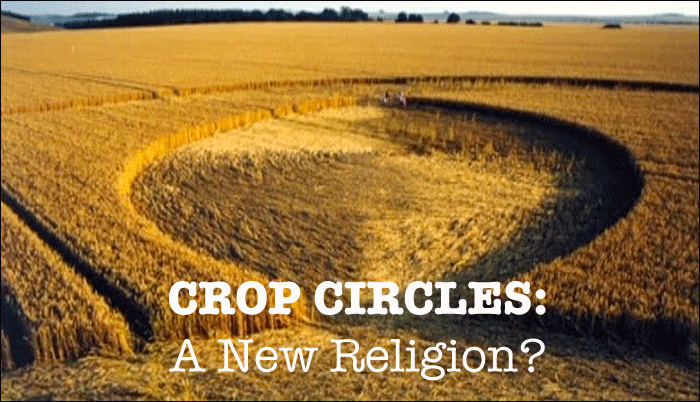
|
by Geraldo Fuentes for viewzone
I'll admit it. There's two very good reasons I've never written about crop circles before. First, so many people "believe" that these elaborate formations are not man made. Crop circles have become an interigal part of a number of other belief systems -- aliens, doomsday, reincarnation, convergence, planet-x, paganism, polar shift... Reaching any contrary conclusion is going to offend someone. But there is another reason why I hesitated: I just might discover that they are indeed a "real" phenomenon, created or inspired by something that is "not human." Once we have crossed that latter threshold there's no turning back. If someone or something is attempting to communicate with our species then we really don't need to have a UFO land on the Whitehouse lawn. They're already here. And chances are, they've been here for a while. Crop Circles are not new.
The woodcut served as a kind of printing press back then and so it also has text which tells of a greedy farmer, who, having refused to pay a mower a reasonable rate for reaping his oats, swore that he would rather have the Devil do the work. The following morning the farmer awoke to find his crop harvested with perfect circles. The exactness suggested that no human could have done this in the dark, much less in only one night. The farmer was afraid to collect his harvest and considered the circles to be something supernatural. More circles were found in England in July 1880. Amateur scientist John Rand Capron reported about strange circles he found in a crop field near Guildford in Surrey. Capron's reported:
"The storms about this part of Surrey have been lately local and violent, and the effects produced in some instances curious. Visiting a neighbour's farm on Wednesday evening (21st), we found a field of standing wheat considerably knocked about, not as an entirety, but in patches forming, as viewed from a distance, circular spots.World War II Crop Circles In 2001 some files were declassified which revealed that the British secret service, MI5, had deemed it necessary to investigate some crop circles that were appearing in along the East Coast of Britain during WWII. The agency had learned that in Poland, Holland, France and Belgium, Nazi sympathizers were cutting patterns in corn fields to serve as guides to aircraft. Some of the patterns were "beat down" plants and were described as being circular with an average diameter of twenty meters. 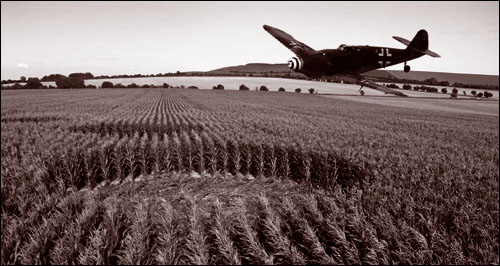 The same phenomenon was witnessed in British landscapes and MI5 was worried that this was an attempt to communicate with the enemy, possibly to direct bombing raids towards London. MI5 investigated a number of crop circles that appeared in various British fields from 1940-1943 to determine if any of those same formations were coded message intended for German pilots flying overhead. Apparently not. Whoever made the crop circles, and for what purpose, remains a mystery. Circles up to 1990
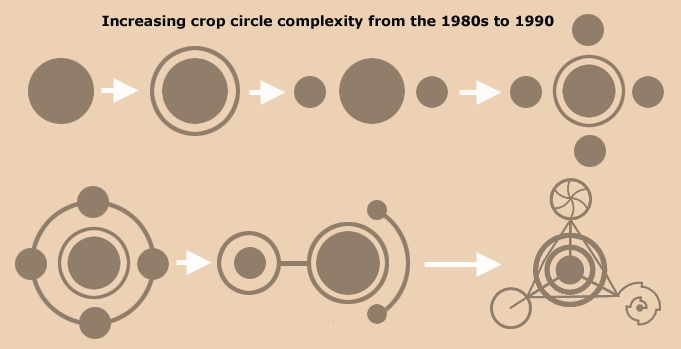 Originally, all crop circles were just that -- circles. The crops, whether rapeseed, rye, wheat or even corn, were flattened in a circular direction, usually counter clockwise, and were solitary formations. Later on, rings and multiple circles were seen. The first multiple circles were usually a central circle with two half-size circles placed bilaterally. Then four half size circles started to appear and these began to be associated with traditional Celtic designs, adding a historical and "other worldly" element to the phenomenon. Around 1990, after the media started to take an interest in crop circles, more complex arrangements appeared with circles connected by straight lines, called "bridges." Some were quite large, recorded at over 360 feet in length. The interior of the circles sometimes showed a pattern and the direction of the felled plants changed to contribute to the design. Occasionally odd shaped were extending from the edge of the circles leading some people to theorize that the circles were "saying something" in a graphic language yet to be understood. The first completely novel crop circle appeared in 1991. Called the Barbury Castle tetrahedron, this design stimulated even more belief that the shapes were communicating some special message and that the creators were of non-human intelligence.
For most people, the "belief" in "real" crop circles centers around who created them. Real crop circles, according to believers, simply could not be made by humans. Theories of their construction range from tornadoes, atmospheric plasma and magnetic energy to unknown intelligences which manifest in glowing orbs and UFOs. As we will discuss later, this only distracts from the real significance of the crop circle phenomenon and may actually be a moot point. In 1999, researcher Colin Andrews received funding from Laurence Rockefeller to conduct a two-year investigation into crop circles. His team concluded that 80% of all crop formations that appeared in England throughout 1999 and 2000 were unquestionably man-made and instigated by business and media interests. However the team could not account for the nature of the remaining 20%, which were termed "genuine". Andrews stated that he had encountered such "unexplainable" patterns 20 years earlier. The fact that complex crop circles could be made by humans in the dark in just a few hours has been well established. "Circle makers", as they call themselves, have gone to lengths to prove this. One circle maker who goes by the handle "Midnyte" has even published his designs on the internet before he made the circles. He posts them in encrypted form for anyone to download. Then, after the crop circle has been made, he publishes the special codes that decrypts the design for comparison. Despite having approached all of the top crop circle believers in the UK, he has received no response. Still, the circles he has constructed are regarded as "real" and are witness to a plethora of paranormal and spiritual experiences by the public. Circle makers have even revealed their methods. Letting their eyes adjust to the darkness takes about half an hour, then, often the stars or moon provide enough light to see pretty well. They often use the farmer's tractor paths to gain access near the center of their work areas, thus avoiding any noticeable footprints or crop damage. Next, circles are usually made by a person standing in the center and extending a measuring string which is held taunt by another helper who walks sideways and flattens an arc with his feet. Large areas are flattened with a flat board and rope, called "planking". The large patches (often a meter at a time) of crop that are flattened by this method reduces the stress to individual plants and minimizes the stem breakage. When a straight path is to be made, a wire is fixed to the head or a hat, extending out in front of the circle maker. A loop on the end acts as a sight which is focused on either a pole or landmark as the circle maker advances forward in the crop. Often many small poles are stuck in the ground to give cues and mark specific geometric points. All of this is carefully planned ahead and all evidence is removed upon completion of the circles. The creation of crop circles is not, however, without mistakes. The famous Barbury crop circle [Above right] is a good example. When a precise survey of the formation was taken it was noticed that one of the elements was slightly misaligned. One circle maker, claiming to be responsible for this formation, acknowledged that he had made an error and felt sure that the circle would be deemed a "fake". To his surprise, believers did notice the error but described it as a deliberate message by the non-human designers.
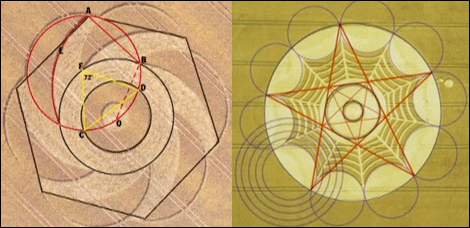 In the past, circle makers used traditional geometric and architectural plans [above] to make their designs. Now they use computers. Although the finished formation may look extremely complicated, breaking the design in to its basic shapes reveals the methods of construction. Other circle makers tell of finishing a planned formation and, just for the heck of it, randomly making several circles or additions to the original design before they left the field. Rather than being noticed as irregular, believers often attached significance to these additions and saw them as highly meaningful. Doug and Dave At the height of the media's interest in crop circles, two gentlemen calling themselves "Doug and Dave" (Doug Bower and Dave Chorley) announced that thy had secretly made hundreds of crop circles in the UK, using planks and rope. The media was quick to believe these claims and the whole phenomenon was called a hoax. While these two men did demonstrate their skill in making a number of crop circles, their claims were shown to be exaggerated when they could not remember specific details and were proven not to have made circles for which they took credit. Today's circle makers are not old men who hang out at the local pub. They are well educated and use computers to design and plan their crop circle formations. An analysis of their creations will likely reveal binary computer code, Einstein's theories, prime numbers or a variety of advanced scientific symbols. Execution of the formations is rehearsed with all of the coordination and professionalism you would expect to see at Circ de Soliel. The idea is, after all, to make the audience think that they have witnessed something impossible. Most circle makers are silent about their work. They seek no publicity, recognition or financial compensation. This only adds to the mystery of crop circles. Why would anyone expend such effort? What could possibly be the benefit? Surprisingly, circle makers do have purpose. Matthew Williams explains:
Some formations are impossible to explain The enigma of crop circles is wonderfully illustrated in the formation, known as the Julian Set, that appeared next to Stonehenge. This formation is extremely complex, both in design, layout and execution -- yet it appears to have been made in broad daylight, hundreds of meters away from a busy highway, in under 45 minutes!
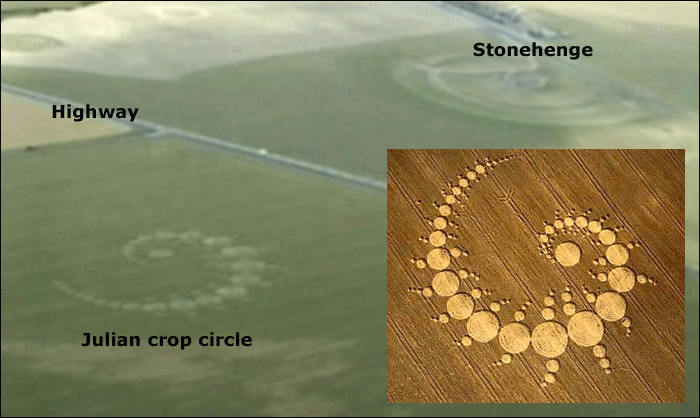 On July 7, 1996 a pilot and photographer were flying circles around the famous Stonehenge site in mid-afternoon. They made several passes around the area before the pilot landed at a nearby airport to refuel. After about 40 minutes, the pilot took off again, leaving the photographer at the airfield. When has passed over a field adjacent to Stonehenge he was shocked to see a huge formation of circles that was not there before. The circles appeared to make a fractal formation called a "julian set" and thus the formation got its name. Not only was this formation extremely complex in its design, but the execution of the crop circle is clearly impossible to complete in less than one hour. Also, it was made just hundreds of yards from a busy highway, yet no one reported seeing any activity prior to its discovery by the pilot. Once the formation was announced, hundreds of people came to the area. The farmer, who originally was angry that his crop had been destroyed by the formation and subsequent trespassing of curious visitors, finally decided to charge admission to see what he called "Europe's Best Crop Circle." To this date, the Stonehenge Julian formation is the best documented enigma. No one has yet claimed responsibility for it, nor has anyone explained how it was made so fast and clandestine.
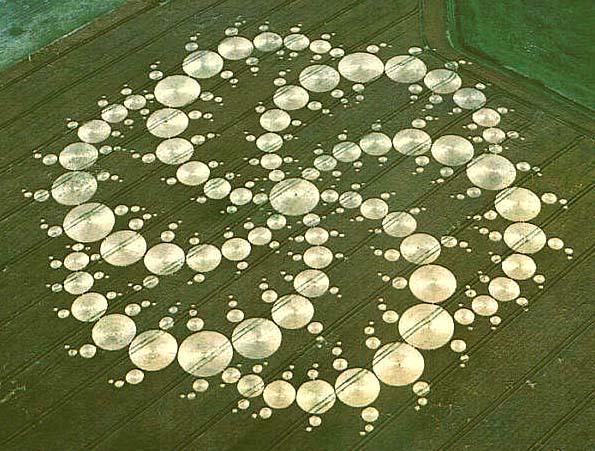 Traditionally, crop circles have increased in complexity and size. The formation [above] is an elabotate triskelion design based on the earlier Julian formation. So far, no one has claimed to be the creator of this huge formation. Physical evidence inside (and outside) of the Crop Circles If one believes that some of the "real" crop circles are not made by planking (human creation) then there are a number of interesting theories to explain how the crops are bent. Rapeseed, one of the favorite mediums, is a very brittle plant which usually will break if the long narrow stalks are bent. While there are many broken stalks in the crop circles, many plants exhibit a very unusual phenomenon where the "nodes" are bent, not broken. Just like bamboo grows in segments, rapeseed stalks have segments which are connected by a special formation called a node which has the ability to be somewhat dynamic and orient the growing plant to maximize exposure to the sun. The node is not flexible, but it does have active cells that can grow quicker on one side or the other to change the plants orientation. 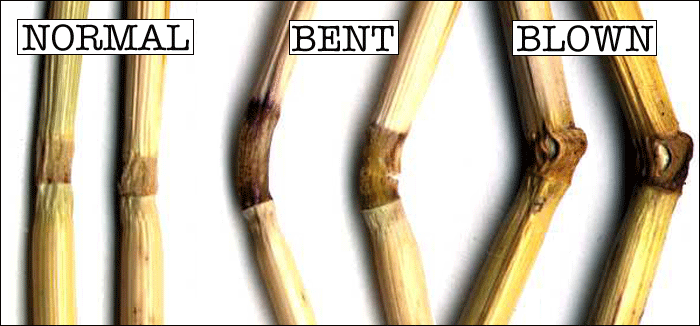 In "real" crop circles it has been observed that the nodes are often bent -- sometimes at 90 degrees -- and this accounts for the horizontal positioning that makes the designs of the crop circle. Other nodes exhibit holes in the nodes, while surrounding crops show none of these changes.
But some skeptics argue that this is not a sign of anything unusual. Since the purpose of the nodes is to orient the plant vertically, a felled plant (i.e. by planking) should be expected to have unusual node growth as it tries to re-orient the plant vertically. They claim that the observed changes in the nodes happened after the plants were flattened. And what about the "popped" nodes? These same skeptics claim that the hot sun, together with the fermentation of the felled plants, is capable of generating enough heat to cause the moisture in the plants to explode through the softened nodes. 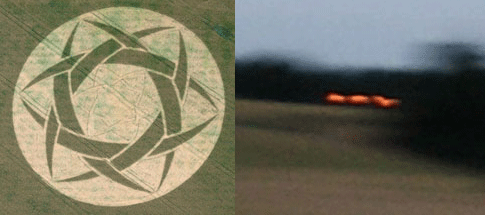 [above:] A wheat formation of two, 6-pointed stars, one of dark standing crop and the second star in the middle defined by flattened wheat angles, were reported July 10, 2010, near the Guy's Cliffe house in Old Milverton, Warwickshire, England. Right: Three orange lights moving near Guy's Cliffe, Warwickshire, U.K., wheat formation on July 12, 2010, caught on low-light shutter speed. (Aerial image © 2010 by Lucy Pringle. Lights © 2010 by Andrew Pyrka.) Laboratory tests have demonstrated that both bending and popping can be simulated by subjecting the plants to microwave energy. But how this energy could be directed at the crops, in specific shapes and designs, remains a mystery. UFO enthusiasts often describe glowing orbs of light that seem to be hovering over newly formed crop circles, as if "directing" some type of energy to make the formations.
Some, including the chief investigator Nancy Talbot of the BLT Group which has extensvely investigated the crop circle phenomenon, have claimed that plasma from the ionosphere causes the formations. They say that the energy may have some type of intelligence that we cannot yet comprehend. But skeptics ask why this intelligence is only just now making complex formations and fractal designs. Why have we not seen these intelligent "messages" in the past? Could it be that we are only just now prepared to recognize and interpret these shapes and symbols? Are Crop Circles a Religion? Even though they make some of the crop circles, the human artists in the UK will tell you that there is something "other worldly" about crop circles. Many tell of strange lights, glowing orbs and sudden mist and fog that often accompanies them during their work in the fields. One circle maker describes how his group were beginning to make a formation when a heavy rainstorm moved in to the area. As they were about to quit, the sky above them suddenly parted and created a hole in the clouds that somehow kept their field dry just long enough for them to complete their work.
All of this begins to sound very much like a religion. There is the belief in a higher power, beneficial spiritual comfort and introspective centering, hidden mysteries and something called faith -- which is the phenomenon of overcoming rational doubt. Yes, crop circles are a religion connecting us to our past and future. And like religion, it is a personal experience undiluted by the opinion of others. Many might argue whether Jesus existed, or if he was a mortal man or deity, but none would doubt that his message was strong, good and enduring. The same might be said of crop circles.
If belief in Crop Circles is a new religion, then the formations themselves serves as its temple or church. Made of living material, crop circles serve as monuments dedicated to nature. Yes, they are temporary. Like the Tibetan mandalas [right] which are created in sand and swept away, crop circles are routinely harvested by farmers. They remind us that we too are temporary and that material attachments only bring sadness. As one circle maker said, "The crop circle power has more energy when they dont know the origin ... by thinking it is paranormal it becomes paranormal ... meditation and thinking brings it to reality." What do YOU think?
|
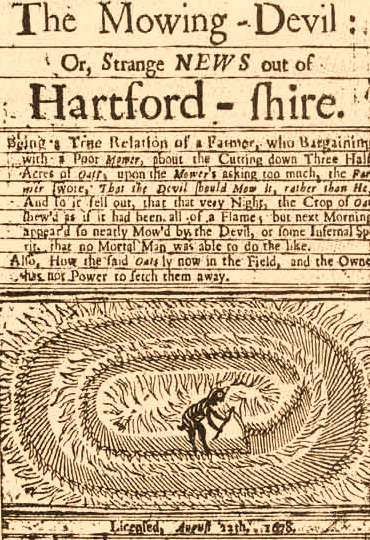 This is a depiction of a crop circle from 1678 [right], shortly after the Pilgrims came to Plymouth Rock. It was found in a woodcut with the title 'Strange News out of Hartford-shire'. It depicts a devil-like creature cutting out a circular pattern in an oat field with a scythe.
This is a depiction of a crop circle from 1678 [right], shortly after the Pilgrims came to Plymouth Rock. It was found in a woodcut with the title 'Strange News out of Hartford-shire'. It depicts a devil-like creature cutting out a circular pattern in an oat field with a scythe.
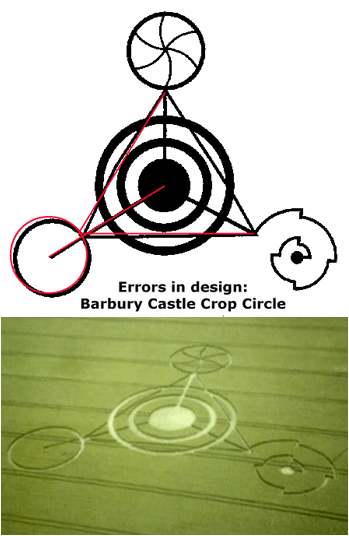 Human or Non-Human Creations?
Human or Non-Human Creations?
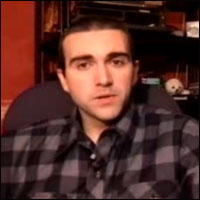 "I don't like researchers who say... [crop circles] can't be made by humans when they haven't even spoken to the people who are making them! ... It doesn't matter who's making the crop circles. It's a very large magic symbol like a talisman. It has a power that goes beyond just the simple form and shape. I don't like the word "hoaxing." Hoaxing implies an intent to fool, to sort of ridicule and that's not what crop circles are about. I don't go out on a daily basis to make crop circles that are going to fool people. I go out to make crop circles that are going to give people experiences and make them happier in their lives, make them understand themselves and look inwards. It's about a spiritual endeavor. This is why people keep coming back -- it's something good -- something beneficial which brings the circle makers back time after time.
"I don't like researchers who say... [crop circles] can't be made by humans when they haven't even spoken to the people who are making them! ... It doesn't matter who's making the crop circles. It's a very large magic symbol like a talisman. It has a power that goes beyond just the simple form and shape. I don't like the word "hoaxing." Hoaxing implies an intent to fool, to sort of ridicule and that's not what crop circles are about. I don't go out on a daily basis to make crop circles that are going to fool people. I go out to make crop circles that are going to give people experiences and make them happier in their lives, make them understand themselves and look inwards. It's about a spiritual endeavor. This is why people keep coming back -- it's something good -- something beneficial which brings the circle makers back time after time. [The circle makers] are having their own experiences and they're helping other people to have experiences." -- Matthew Williams (Circlemakers)
[The circle makers] are having their own experiences and they're helping other people to have experiences." -- Matthew Williams (Circlemakers)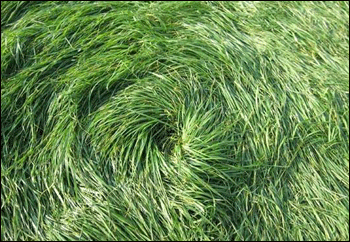 One good theory is that some sudden and extreme heat source has cooked the moisture inside the crops, causing the nodes to become soft (as if steamed from the inside) and, in some cases, to pop open under pressure. Indeed this has become the objective method for determining if a crop circle is "real" and samples of the plants are now routinely gathered for this assessment.
One good theory is that some sudden and extreme heat source has cooked the moisture inside the crops, causing the nodes to become soft (as if steamed from the inside) and, in some cases, to pop open under pressure. Indeed this has become the objective method for determining if a crop circle is "real" and samples of the plants are now routinely gathered for this assessment.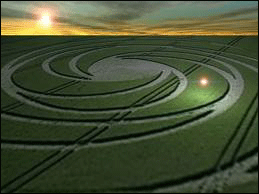 While there are some excellent examples of "orbs" filmed in or near crop circles, the most famous one was publicly debunked while others were thought to be out of focus birds. Still, there is enough evidence to warrant further investigation of this claim as new videos keep emerging.
While there are some excellent examples of "orbs" filmed in or near crop circles, the most famous one was publicly debunked while others were thought to be out of focus birds. Still, there is enough evidence to warrant further investigation of this claim as new videos keep emerging.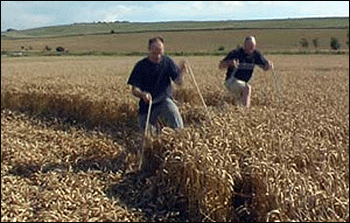 Others relate how making the circles gives them a deep spiritual satisfaction, as if they are doing "God's work". Many now hold prayer or invocations prior to executing their construction. They ask the spirits to protect and guide them while making the circle, and that their work will be for good and positive experiences for others as well as the makers. Almost all circle makers believe they are doing good and that the designs and messages that their crop circles exhibit are, in part anyway, inspired by something (or someone) greater than themselves.
Others relate how making the circles gives them a deep spiritual satisfaction, as if they are doing "God's work". Many now hold prayer or invocations prior to executing their construction. They ask the spirits to protect and guide them while making the circle, and that their work will be for good and positive experiences for others as well as the makers. Almost all circle makers believe they are doing good and that the designs and messages that their crop circles exhibit are, in part anyway, inspired by something (or someone) greater than themselves.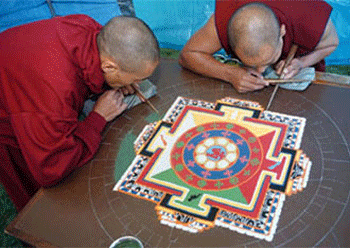 Maybe it is not really useful to examine how the crop circles are made. They are works of art which are greater than the sum of their parts. Just as we relate to the "message" in a painting by Van Gough or DaVinci, we do not need to know the technique or how the paint was applied to react to the totality of the finished piece. Artists, like the circle makers, often feel that the art comes "through" them and they feel privileged to be allowed this special honor.
Maybe it is not really useful to examine how the crop circles are made. They are works of art which are greater than the sum of their parts. Just as we relate to the "message" in a painting by Van Gough or DaVinci, we do not need to know the technique or how the paint was applied to react to the totality of the finished piece. Artists, like the circle makers, often feel that the art comes "through" them and they feel privileged to be allowed this special honor.